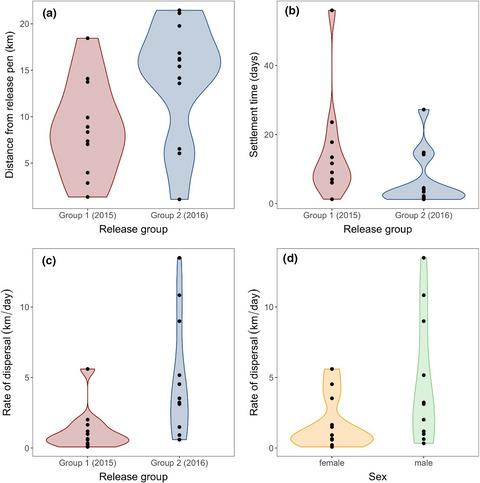当前位置:
X-MOL 学术
›
Ecol. Evol.
›
论文详情
Our official English website, www.x-mol.net, welcomes your
feedback! (Note: you will need to create a separate account there.)
Postrelease movement and habitat selection of translocated pine martens Martes martes.
Ecology and Evolution ( IF 2.3 ) Pub Date : 2020-05-14 , DOI: 10.1002/ece3.6265 Catherine M McNicol 1 , David Bavin 1, 2 , Stuart Bearhop 3 , Josie Bridges 2 , Elizabeth Croose 2 , Robin Gill 4 , Cecily E D Goodwin 1 , John Lewis 5 , Jenny MacPherson 2 , Daniel Padfield 1 , Henry Schofield 2 , Matthew J Silk 1, 3 , Alexandra J Tomlinson 5 , Robbie A McDonald 1
Ecology and Evolution ( IF 2.3 ) Pub Date : 2020-05-14 , DOI: 10.1002/ece3.6265 Catherine M McNicol 1 , David Bavin 1, 2 , Stuart Bearhop 3 , Josie Bridges 2 , Elizabeth Croose 2 , Robin Gill 4 , Cecily E D Goodwin 1 , John Lewis 5 , Jenny MacPherson 2 , Daniel Padfield 1 , Henry Schofield 2 , Matthew J Silk 1, 3 , Alexandra J Tomlinson 5 , Robbie A McDonald 1
Affiliation

|
Monitoring postrelease establishment and movement of animals is important in evaluating conservation translocations. We translocated 39 wild pine martens Martes martes (19 females, 20 males) from Scotland to Wales. We released them into forested areas with no conspecifics in 2015, followed by a second release in 2016, alongside the previously released animals. We used radio‐tracking to describe postrelease movement and habitat selection. Six martens (15%) were not re‐encountered during the tracking period, of which four undertook long‐distance dispersal. For the remaining individuals, we characterized two phases of movement, “exploration” followed by “settlement,” that differed between releases. In the first release, martens remained in exploration phase for a mean of 14.5 days (SE = 3.9 days) and settled at a mean distance of 8.7 km (SE = 1.8 km) from release sites, whereas martens released in year two, alongside resident conspecifics, traveled away from release sites at a faster rate, settling sooner, at a mean of 6.6 days (SE = 1.8 days), but further, at a mean distance of 14.0 km (SE = 1.7 km) from release sites. Animals released in year one did not exhibit habitat preferences overall but within forests they favored recently felled areas, whereas animals released in year two showed strong selection for forested habitat but did not discriminate between forest types. The presence of conspecifics appeared influential for settlement and site fidelity of translocated martens and was associated with more rapid but more distant dispersal of the later cohort. Releases of animals in close proximity appeared to promote site fidelity and rapid establishment of ranges in the recipient environment.
中文翻译:

易位松貂貂的放归后运动和栖息地选择。
监测动物放归后的定居和移动对于评估保护易地非常重要。我们将 39 只野生松貂貂(19 只雌性,20 只雄性)从苏格兰转移到威尔士。 2015 年,我们将它们释放到没有同种动物的森林地区,随后在 2016 年与之前释放的动物一起进行了第二次释放。我们使用无线电跟踪来描述释放后的运动和栖息地选择。 6只貂(15%)在跟踪期间没有再次遇到,其中4只进行了长距离扩散。对于剩下的个体,我们描述了两个运动阶段,“探索”和“解决”,这在版本之间有所不同。在第一次释放中,貂平均处于探索阶段 14.5 天( SE = 3.9 天),并定居在距释放地点平均距离 8.7 公里( SE = 1.8 公里)的地方,而貂在第二年被释放,与常驻者一起同种动物以更快的速度离开释放地点,稳定得更快,平均需要 6.6 天( SE = 1.8 天),但距离释放地点平均距离为 14.0 公里( SE = 1.7 公里)。第一年释放的动物总体上没有表现出栖息地偏好,但在森林中它们更喜欢最近砍伐的地区,而第二年释放的动物对森林栖息地表现出强烈的选择,但不区分森林类型。同种动物的存在似乎对易位貂的定居和地点保真度有影响,并且与后来群体更快但更远的扩散有关。近距离释放动物似乎可以促进地点保真度并在受体环境中快速建立范围。
更新日期:2020-05-14
中文翻译:

易位松貂貂的放归后运动和栖息地选择。
监测动物放归后的定居和移动对于评估保护易地非常重要。我们将 39 只野生松貂貂(19 只雌性,20 只雄性)从苏格兰转移到威尔士。 2015 年,我们将它们释放到没有同种动物的森林地区,随后在 2016 年与之前释放的动物一起进行了第二次释放。我们使用无线电跟踪来描述释放后的运动和栖息地选择。 6只貂(15%)在跟踪期间没有再次遇到,其中4只进行了长距离扩散。对于剩下的个体,我们描述了两个运动阶段,“探索”和“解决”,这在版本之间有所不同。在第一次释放中,貂平均处于探索阶段 14.5 天( SE = 3.9 天),并定居在距释放地点平均距离 8.7 公里( SE = 1.8 公里)的地方,而貂在第二年被释放,与常驻者一起同种动物以更快的速度离开释放地点,稳定得更快,平均需要 6.6 天( SE = 1.8 天),但距离释放地点平均距离为 14.0 公里( SE = 1.7 公里)。第一年释放的动物总体上没有表现出栖息地偏好,但在森林中它们更喜欢最近砍伐的地区,而第二年释放的动物对森林栖息地表现出强烈的选择,但不区分森林类型。同种动物的存在似乎对易位貂的定居和地点保真度有影响,并且与后来群体更快但更远的扩散有关。近距离释放动物似乎可以促进地点保真度并在受体环境中快速建立范围。











































 京公网安备 11010802027423号
京公网安备 11010802027423号